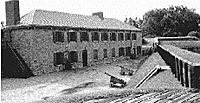 Similar to Fort Niagara, Fort Erie (located in the city of the same name) was a pile of ruins by the 1930's, when Canadian federal and provincial parks authorities began restoring it, reopening it to the public in 1939. A good thing since its history and appearance are distinctive.
Similar to Fort Niagara, Fort Erie (located in the city of the same name) was a pile of ruins by the 1930's, when Canadian federal and provincial parks authorities began restoring it, reopening it to the public in 1939. A good thing since its history and appearance are distinctive.
At the end of the French and Indian War, the British started construction of a line of forts along the Niagara River to safeguard their communications with the upper Great Lakes. The original Fort Erie was the first in this line, and was constructed in 1764. It functioned for fifty years as a port and supply depot, but was repeatedly damaged by winter storms. As a result, in 1805 the British started building a new fort, this one of stone, slightly inland and uphill from the old one at the riverside.
Fort Erie was unfinished when the War of 1812 broke out, and was partially dismantled by the small garrison before it withdrew. The Americans then seized the fort and held it against a British siege. At the end of the war, the Americans went back across the river to Buffalo, and destroyed Fort Erie on the way. British troops then occupied the ruins until 1823, guarding the borders against renewed hostilities.
In terms of military engineering, Fort Erie is markedly different than Fort Niagara. It is much smaller, and could easily fit inside the latter fort's massive parade ground. Reflecting its shorter history and fewer changes of occupation, the fort is more cohesive in design. One can see the earthen walls of the British era fort, with two stone bastions, faced on the inland side with a stouter American period addition of two more stone bastions and a stone curtain wall, on the foundations of structures begun by the British. But they are very similar in design, and use identical building materials. On the other hand, one wall of Fort Niagara, built during the mid-nineteenth century, has courses of two different types of stone, showing when the Army switched contractors.
Fort Erie reveals some major differences as wells in how a site can be presented to the public. Consistent with other Canadian military sites, Fort Erie relies on interpreters in period costume for its historical cachet. This approach places a strong accent on reenactments, and reenactors, not just for special occasions, but for the day to day operations. The exhibits within the fort necessarily accent the War of 1812. The barracks are furnished to contrast the living conditions of officers and enlisted men, showcase weapons, and in one interesting instance, the exhumation of a nearby American military cemetery, and the reinterment of the dead in New York state. Consistent with the reliance on interpreters, there is an enhanced emphasis on how the soldiers lived and died, and their experiences of service and war, as much as on cold stone engineering. Besides this conflict, Fort Erie houses a comprehensive collection of Canadian army unit badges from World War I. Unfortunately, it is resented almost as an afterthought, with almost no solid historical background information, in a nearly bare room.
Niagara Frontier Touring the Restored Forts
-
Niagara Frontier: Introduction
Niagara Frontier: Fort Niagara
Niagara Frontier: Fort Erie
Niagara Frontier: Fort George
Niagara Frontier: Fort Mississauga
Niagara Frontier: Battlefield of Queenston Heights
Niagara Frontier: Getting There
Back to Cry Havoc #18 Table of Contents
Back to Cry Havoc List of Issues
Back to MagWeb Master Magazine List
© Copyright 1996 by David W. Tschanz.
This article appears in MagWeb (Magazine Web) on the Internet World Wide Web. Other military history articles and gaming articles are available at http://www.magweb.com